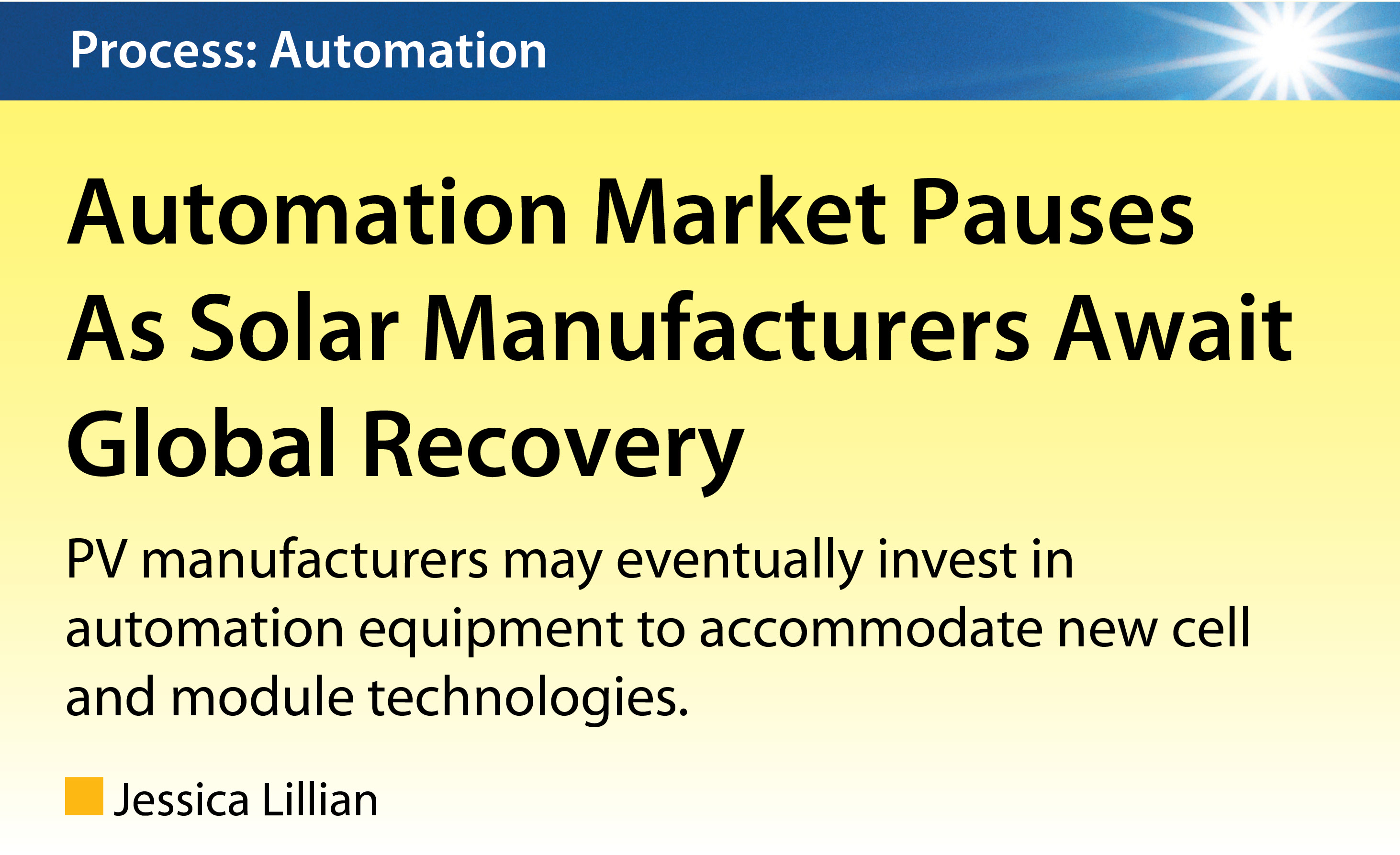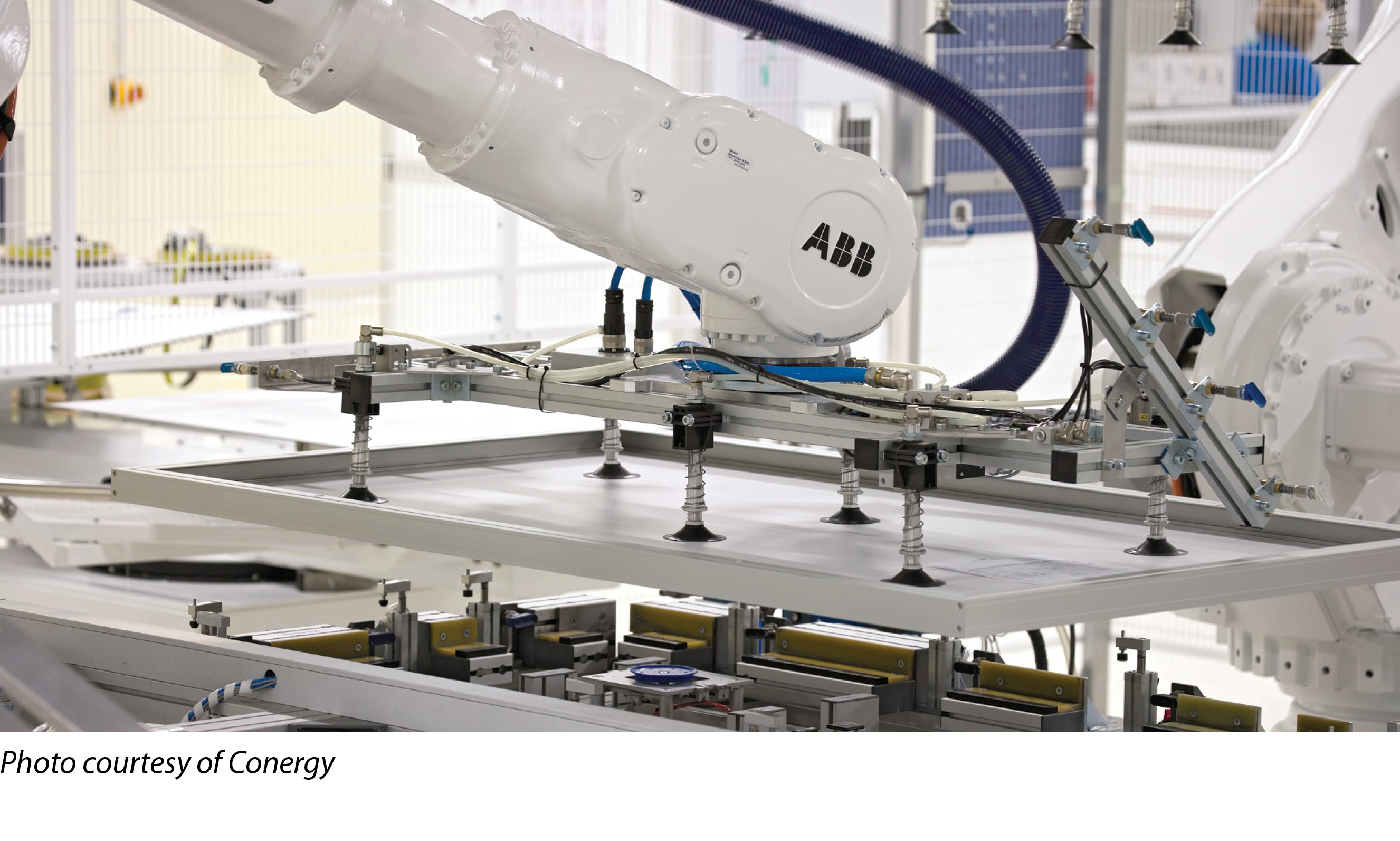

301 Moved Permanently
During the PV manufacturing industry’s exuberant expansion years, providers of robotics and other automation equipment grew alongside module makers, helping them keep pumping out ever-higher capacities of cells and modules.
Full-size demonstration units of the latest automation equipment hummed on the floors of every major trade conference. Industry executives sometimes even touted automation as the key to enabling European and U.S.-based factories to compete with their Chinese counterparts.
Now that painful contraction has begun in the PV manufacturing sector, claiming little-known start-ups and one-time industry titans alike, the manufacturing equipment market must endure a severe slowdown of its own. For some equipment vendors, the stark current reality of painfully slow - or nonexistent - sales in the solar market will eventually ease, with new opportunities emerging as manufacturers implement innovative cell and module technologies and sharpen their focus on quality.
However, recovery will be slow, according to industry experts, and conditions at the moment appear discouraging. Stephan Raithel, the European Union director of PV for industry organization SEMI, describes current equipment purchasing levels - including investment in automation equipment - as “close to zero.”
With most manufacturers cutting or maintaining capacity rather than adding new lines or opening new factories, equipment installations taking place are limited to upgrades to replace decommissioned machinery - generally only small segments of the full equipment line. “Even tier-one manufacturers have clearly stated that their focus is upgrading existing lines,” Raithel says.
When asked if they had recently bought any new automation equipment, neither module manufacturer interviewed for this story reported any specific purchases. Rather, both described their general activities with their automation partners simply as an ongoing collaboration.
“We are constantly in touch with Japanese and European equipment makers to get updates on the improvement of throughput,” says Sascha Rossmann, international sales director at Winaico. The company manufactures in Taiwan, at an annual 150 MW capacity. Significant expansion plans call for a ramp-up to 300 MW in 2014 and 500 MW in 2015, Rossmann adds.
Germany-based Conergy AG, meanwhile, currently operates a 280 MW factory in Frankfurt. Sonja Schreiner, the company’s public relations manager, says that upgrades to the fab’s automation equipment represent a “part of the continuous improvement process in the factory.” The module production process is fully automated, with the exception of three manual quality-assurance steps at cell lay-up, after frame mounting and after flashing.
Winaico and Conergy likely speak for most manufacturers in their current approach to automation. Raithel says that in conversations with equipment providers and cell and module manufacturers, he has found that “planning mode” remains the dominant status.
Not surprisingly, Karl-Heinz Bahnmüller, managing director at Schiller Automation GmbH, reports empty order books in the solar segment. Industry-wide, he predicts that activity could pick up in “significant” amounts by mid-2014 at the earliest.

Road to recovery
Typical manufacturing technology investment cycles dictate long lead times. Therefore, even though some industry forecasts call for automation equipment investment to pick up again in the third or fourth quarter of next year, Raithel believes even these timetables may be premature.
“You usually have six to 12 months’ production time for tools before you can deliver them,” he adds. “You would need the order now if there were anything for next year, and we haven’t heard that.”
In the meantime, sector diversification may be helping solar automation equipment providers weather the downturn.
“Some are leaving the business or changing their model,” Raithel says. “Usually, the automation companies are focused on several industry segments.”
Many of the largest robotics companies have historically sold into the semiconductor and/or automotive manufacturing markets, in addition to PV.
These types of firms, including familiar names such as Reis and Kuka, boast broad portfolios and can temporarily reallocate solar-focused resources, Raithel explains. The only vendors in danger of failing altogether due to weakness in the solar manufacturing sector will likely be the smallest suppliers or those that focus solely on turnkey lines, he adds.
Innovations
Although solar manufacturers’ and equipment vendors’ research and development efforts remain ongoing despite the current slowdown, most industry executives agree that pushing new tools into the market would not yet be advisable unless manufacturers demonstrated a clear commitment to go in a particular direction with their automation needs.
When it comes to the latest and greatest automation equipment, “We haven’t seen any quantum leaps - just evolutionary progress,” Conergy’s Schreiner says.
Winaico’s Rossmann describes the absence of recent technology breakthroughs even more candidly: “There are no major achievements,” he states.
Schiller has not recently released any new products or technologies in the solar space, Bahnmüller says, adding that he knows of no significant new technologies in the market at large.
In general, state of the art for such machinery these days is represented by “high-speed handling systems with extraordinarily high availability and reliability in order to increase the overall equipment effectiveness,” he says.
“Good automation enables mass production while maintaining the highest quality standards,” agrees Schreiner.
Continuing to meet those demands will require equipment providers to work closely with manufacturers as they increasingly embrace new and innovative cell and module technologies - a trend that is expected to take hold once current market conditions improve.
Specifically, glass-glass modules and new interconnection structures will make inroads, requiring new automation equipment, Raithel predicts.
“For now, it’s difficult with the automation technology in fabs to actually manufacture with relatively low power losses when it comes to the interconnect,” he says. “Heterojunction requires thin cells, which can cause issues with breakage rate or flexibility.” A few promising technology concepts, including touchless handling ideas and ultrasonic automation machinery, offer potential solutions.
No matter the specific solutions implemented, Raithel and other industry experts agree that in the future, automation will play an even more vital role in factories as manufacturers roll out their new technologies - and increase their focus on speed and quality.
With cycle times dropping below 1 second per cell, consistent product results are only achievable through automation, Bahnmüller says.
At the same time, Rossmann warns, solar manufacturers must not adopt a belief that automating a factory guarantees a lower labor burden and better chance of success. Process control will be an increasingly important part of the picture.
“There is an increased tendency toward automation,” he says. “But automation does not mean to leave the equipment alone by itself and it will do its job. Automation does not make production easier; it makes it more complex and challenging to get the best results out of the equipment.” R
Process: Automation
Automation Market Pauses As Solar Manufacturers Await Global Recovery
By Jessica Lillian
PV manufacturers may eventually invest in automation equipment to accommodate new cell and module technologies.
si body si body i si body bi si body b
si depbio
- si bullets
si sh
si subhead
pullquote
si first graph
si sh no rule
si last graph